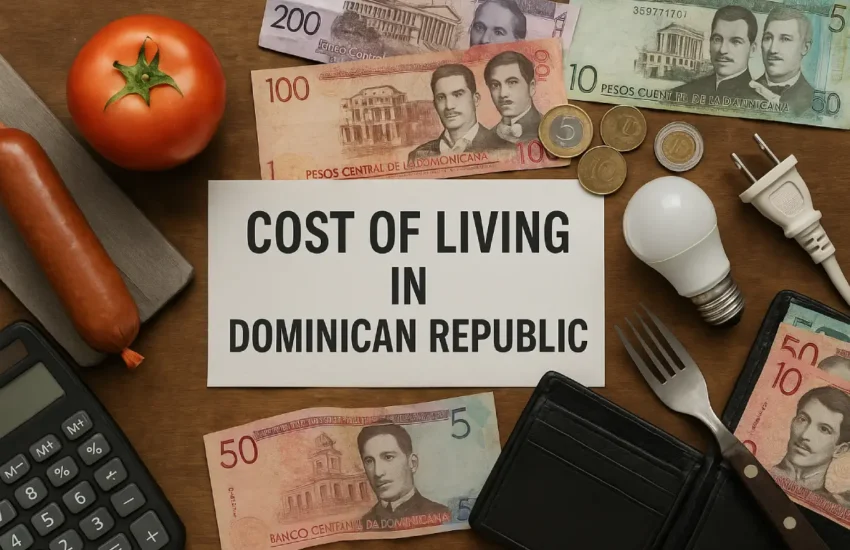Why The Cost of Living in Uruguay Shocked This American Expat
Americans often experience sticker shock from the cost of living in Uruguay, which defy expectations of affordable South American prices. The country stands as Latin America’s second most expensive nation and costs more than 66% of countries across the globe. Life in Uruguay costs 23.4% less than the United States – a smaller gap than most expatriates expect.

The numbers paint a clear picture of Uruguay’s costs compared to the USA. Monthly expenses reach $3,098 to support a family of four, while single individuals need $869 before rent. Rental prices sit 66.7% below U.S. levels. Montevideo’s cost of living exceeds Buenos Aires by 11% and Rio de Janeiro by 55%.
A couple should plan for $3,200 monthly to live in a two-bedroom Montevideo apartment. These costs catch many people off guard, especially retirees who compare them with Mexico’s or Costa Rica’s living expenses. Many discover that this South American destination isn’t the budget-friendly haven they imagined.
First Impressions: Why I Thought Uruguay Would Be Cheaper
My dreams of a cheaper lifestyle drew me to South America. Like many others, I believed the region would be easy on my wallet compared to North America. Life in Uruguay taught me a different lesson.
Expectations based on cost of living in Uruguay vs USA
Research showed Uruguay’s cost of living is just 23.4% lower than the United States. This small difference raised red flags, especially since other Latin American countries save you 40-60%. Rent prices in Uruguay are 66.7% lower than the United States. Yet other expenses matched or exceeded U.S. prices.
The numbers became clearer once I converted everything to U.S. dollars. Monthly expenses for one person (without rent) add up to $869. This amount exceeded my budget, which I’d created from friends’ experiences in other South American countries.
The biggest surprise came from utility bills. A simple apartment in Uruguay needs $139 monthly for basic utilities. This amount was nowhere near what I paid in most U.S. cities. Imported items and electronics cost a fortune too—an iPad sells for $1,170, double the U.S. price.
Comparing Uruguay to living costs in Costa Rica and Mexico
Costa Rica and Mexico topped my list of potential expat destinations before Uruguay. A deeper analysis would have helped me make a better choice.
Uruguay costs almost the same as Costa Rica, with just a 1.3% difference without rent. Daily expenses tell a different story. Restaurant prices in Uruguay exceed Costa Rica’s by 14.2%. My regular dining habits turned into special occasions.
Mexico offers better value. Uruguay’s living costs are 35.3% higher than Mexico’s (without rent). Eating out costs 41.8% more in Uruguay, and groceries are 21.0% pricier. Both restaurants and home cooking strain the wallet more in Uruguay.
Daily expenses hit retirees and singles hard. A simple restaurant meal in Uruguay sets you back $18, while Mexico charges just $10.
Getting around costs more too. Monthly public transit passes in Uruguay cost $60, while Mexico charges only $22. These differences matter a lot if you plan to live long-term in Costa Rica, Uruguay, or Mexico.
Healthcare costs surprised me despite Uruguay’s reputation. Private doctor visits cost $80 here compared to $26 in Mexico.
This experience taught me to look beyond surface-level country comparisons. A full picture of Uruguay’s living costs would have helped me plan better or choose differently.
The Real Cost of Living in Uruguay in U.S. Dollar
Life in Uruguay hit me like a ton of bricks when I started looking at specific expenses in U.S. dollars. My spreadsheet projections painted a different picture from what I found on the ground, even after doing my research.
Housing surprises in Montevideo and beyond
Housing costs in Uruguay took me by surprise with their dramatic variations by location. A decent one-bedroom apartment in Montevideo’s city center costs approximately $579.50 monthly. You can save money by moving just outside the center, where prices drop to around $436. This makes suburban living a better choice for anyone planning to stay long-term.
Families who need more space will find three-bedroom apartments in Montevideo’s city center averaging about $1,000 monthly. Similar homes outside the center cost approximately $777.20. These prices show significant savings compared to Mexico or Costa Rica’s living costs, if you’re flexible about location.
Property purchase prices left me stunned. A small unfurnished waterfront one-bedroom apartment in upscale neighborhoods like Pocitos or Punta Carretas costs around $250,000. Houses in residential areas with sea views range from $500,000 to an astounding $1,000,000.
Montevideo’s cost of living reflects its position as Latin America’s 3rd most expensive city. The city costs more than 60% of cities worldwide – not exactly the retirement bargain I had predicted.
Utilities and internet costs that caught me off guard
Utility bills brought the biggest surprises when comparing costs between Uruguay and the USA. Basic utilities (electricity, heating, cooling, water, garbage) for an 85m² apartment average $135.20 monthly – higher than many U.S. cities.
Electricity stands out at $0.240 per kWh for residential use. Winter heating costs can jump significantly, making energy efficiency crucial for retirees with fixed incomes.
Uruguay has Latin America’s most expensive internet at approximately $45.30 monthly. The quality proves excellent, with fiber optic plans offering 400 Mbps down/30 Mbps up starting around $37 monthly. Users needing more speed can get plans with 1,000 Mbps down/300 Mbps up for about $100 monthly.
Mobile phone plans offer better value, with calls and 10GB+ data costing around $16.90 monthly – less than typical U.S. plans.
These costs affect your budget significantly. A couple in a two-bedroom apartment should set aside approximately $3,200 monthly for all expenses. Single people need around $1,875.
My experience with Uruguay’s financial landscape taught me to create detailed budgets that account for these unexpected costs. Living costs might be 23.4% lower than the United States, but those savings can disappear quickly through overlooked expenses and surprise utility bills.

Food and Daily Expenses: Where My Budget Went Wrong
My first reality check in Uruguay came at the grocery store. The daily food costs showed a very different picture from what I’d read in travel blogs.
Grocery shopping realities vs my expectations
Food prices in Uruguay jumped 5.29% in December 2024, which hit both locals and expats hard in their wallets. A single person now spends around 12,600 $U ($300) monthly on food – way more than what I’d planned based on other South American countries.
The meat prices won’t break your bank – you’ll pay about $10 for a kilogram of grass-fed beef and $8 for chicken. But processed and imported foods will make your eyes water. Here’s what you’ll pay for everyday items when comparing Uruguay to USA:
- Local cheese: 252 $U ($6) per pound
- Milk: 182 $U ($4.30) per gallon
- Apples: 51 $U ($1.20) per pound
The 22% VAT on everything makes grocery bills climb quickly. I learned to save money by shopping at local farmers’ markets (ferias). These markets offer produce at a fraction of supermarket prices and better reflect Uruguay’s actual living costs in U.S. dollars.
Eating out and entertainment costs in Montevideo
Dining out became a special treat rather than an everyday thing. Montevideo’s restaurant prices tell the story: a simple meal at a budget-friendly restaurant costs about 700 $U ($16.60). A nice dinner for two at a mid-range place runs around 2,200 $U ($52).
Don’t count on fast food to save money – a McMeal costs about 470 $U ($11), almost twice what you’d pay in Mexico. Coffee lovers should budget carefully too, with cappuccinos averaging 169 $U ($4).
Your entertainment budget needs careful planning. Movie tickets run about 410 $U ($9.80), and you’ll need 2,265 $U ($54) for a monthly gym membership. These daily costs add up fast for anyone planning retirement here.
There’s a silver lining: foreign credit cards get an 18% VAT discount at restaurants during tourist season. This makes eating out more affordable and closer to Costa Rica’s prices during certain times of the year.
Living in Uruguay taught me a valuable lesson: food costs, not just housing, make or break your budget. Every expat needs to factor these recurring expenses into their financial plans.
Transportation and Healthcare: Hidden Costs I Didn’t Expect
My budget expectations for transportation and healthcare in Uruguay didn’t match reality at all. These two basics really shape how much expats like me spend on daily living here.
Public transport vs owning a car in Uruguay
Living in Uruguay means choosing between budget-friendly public transport and expensive car ownership. A bus ride costs 50 pesos ($1.20), while a monthly pass runs 1,800 pesos ($42.60). This makes daily commutes affordable for anyone planning to stay long-term.
Car ownership here will shock you. Cars cost twice as much as they do in the USA. The government slaps a 23-46% import tax on gas vehicles, plus 22% VAT and extra fees. Your yearly car expenses add up to $4,285 – that’s $504 for depreciation, $580 for insurance, $595 for maintenance, and $1,718 for fuel.
Here’s something that blew my mind: Uruguay ranks 18th out of 21 countries in car ownership costs. Gas prices hit $1.80 per liter, making them some of South America’s highest – almost double what you’d pay in Mexico.
Healthcare costs for a retiree and a single person
Healthcare in Uruguay offers surprising value compared to USA prices, even though the initial costs might raise eyebrows. The system gives you three choices:
- Public healthcare (ASSE) – cheap but you’ll wait longer
- Mutualista private hospital plans – about $70 monthly plus copayments
- Premium private coverage – luxury service for those who want it
Retirees get great value from the mutualista system at roughly $100 monthly for detailed coverage. This covers hospital stays, doctor visits, and emergencies – nowhere near what you’d pay in the US.
Many expats add emergency response services for $25-40 monthly. This extra safety net makes sense for retirees living alone.
Montevideo’s healthcare scene has places like the British Hospital with English-speaking staff. Healthcare plans also help cut medication costs when you’re paying in U.S. dollars.
Healthcare stands out as one area where Uruguay gives you better value than Costa Rica for anyone staying long-term.

Lessons Learned: Adjusting to the Cost of Living in Uruguay
The shock of Uruguay’s expenses hit me hard at first, and I had to figure out ways to make my dollars last longer. Living costs forced me to do more than just look for deals – I had to completely change how I lived.
How I adapted my lifestyle to fit my budget
My first big change was to shop like locals do. I started going to ferias (farmers’ markets) twice a week and bought fresh produce that cost way less than supermarket prices. Learning Spanish phrases to bargain was tough but saved me lots of money.
I gave up my plans to own a car. A bus ride in Montevideo costs about $1.30, while having a car would have cost me an extra $450 each month. This change made a huge difference in my living costs.
Healthcare turned out to be cheaper here than in the USA. I joined a mutualista (private hospital membership) that costs around $70 monthly with small copayments. This gave me great coverage as a retiree.
Yes, it is true that staying on budget meant living more like Uruguayans do. Rather than spending on expensive activities, I found free things to do along Montevideo’s 13-mile coastal Rambla. This was perfect since I wanted to meet people without spending much.
Tips for future expats planning retirement in Uruguay
If you’re thinking about living costs in Uruguay in U.S. dollars, plan for $1,500-$2,500 per month. This will give you a comfortable life without money worries, unlike what my friends tell me about Mexico.
The tax system here works in your favor – Uruguay doesn’t tax foreign income like retirement pensions and Social Security payments. This makes it better than Costa Rica when it comes to living costs.
You should also learn about how prices change with seasons in Montevideo Uruguay, especially if you want to live in beach areas like Punta del Este where summer prices go way up.
Places like Atlántida or Piriápolis offer beach living that costs much less than Montevideo. I wish someone had told me this earlier in my retirement trip.
Cost of Living in Uruguay Frequently Asked Question
What is the average monthly cost of living in Uruguay for expats?
For comfortable living in Uruguay, expats should budget between $1,500 to $2,500 per month. This range covers expenses like housing, food, healthcare, and daily necessities, allowing for a good quality of life without constant financial stress.
How does healthcare in Uruguay compare to the United States?
Healthcare in Uruguay offers good value for expats. The country has a well-regarded healthcare system with both public and private options. Many retirees find the quality of care to be high and costs to be reasonable compared to the U.S., with comprehensive private coverage available for around $100 monthly.
Is Uruguay tax-friendly for U.S. retirees?
Uruguay employs a territorial tax system, which is advantageous for U.S. retirees. Foreign-sourced income, including Social Security benefits and pensions, is generally exempt from Uruguayan taxation. However, U.S. citizens are still subject to U.S. taxation on worldwide income, which requires careful financial planning.
What are some unexpected costs of living in Uruguay?
Some surprising expenses in Uruguay include higher than expected utility costs, especially electricity. Imported goods and electronics often carry substantial premiums. Additionally, owning a car can be significantly more expensive than in the U.S. due to high import taxes and fuel costs.
How does the climate and lifestyle in Uruguay compare to other South American countries?
Uruguay offers a temperate climate with four distinct seasons, without extreme weather conditions. The country is known for its safety, political stability, and relaxed lifestyle. While it may be more expensive than some neighboring countries, many expats find the quality of life, beautiful beaches, and friendly culture to be worth the additional cost.
What is the cost of renting a home in Uruguay for expats?
Rental prices in Uruguay vary depending on location and property type. In Montevideo, a one-bedroom apartment in the city center typically costs around $600–$900 per month, while properties in coastal towns like Punta del Este may range higher during peak seasons. Long-term rentals in smaller towns can be found for under $500.
How affordable is public transportation in Uruguay?
Public transportation in Uruguay is both accessible and affordable. A single bus ride in Montevideo costs about $1, and monthly public transport passes are available for around $40. Intercity buses are reliable and reasonably priced, making travel across the country convenient for expats and tourists alike.
Can expats work or start a business in Uruguay easily?
Uruguay is relatively welcoming to expats looking to work or start a business. While fluency in Spanish is highly beneficial, the process for obtaining a residency permit and business license is straightforward. The government also offers incentives for foreign investors and entrepreneurs in certain industries.
What is the internet and mobile connectivity like in Uruguay?
Uruguay has modern telecommunications infrastructure with high internet penetration. Broadband and fiber-optic connections are widely available in urban areas, with average monthly costs around $30–$50. Mobile coverage is extensive, and prepaid plans are affordable for both voice and data services.
Are there good international schools for expat families in Uruguay?
Yes, Uruguay offers several reputable international and bilingual schools, particularly in Montevideo. These schools follow various curricula such as American, British, and IB programs. Tuition can range from $3,000 to $10,000 per year, depending on the institution and grade level.


